#Bus Routing Software
Explore tagged Tumblr posts
Text
Enhancing School Bus Transportation with SpotBus: The Power of Live GPS Tracking
In today’s digital age, ensuring the safety and efficiency of school transportation is more critical than ever. SpotBus, an innovative school bus tracking app, leverages live GPS tracking to revolutionize how schools manage student transportation. Let’s explore how SpotBus enhances student school bus tracking and overall school bus transportation with its advanced features and capabilities.
The Role of Live GPS Tracking in School Transportation
Live GPS tracking is at the heart of SpotBus, providing real-time location data for school buses. This feature ensures that school administrators, parents, and transport providers can monitor the exact whereabouts of the buses, enhancing safety and efficiency. By using live GPS tracking, SpotBus minimizes the risks associated with delays, route deviations, and unexpected incidents on the road.
Comprehensive Student School Bus Tracking
SpotBus excels in providing comprehensive student school bus tracking. The app logs each student's entry and exit from the bus, creating a detailed record of student attendance. This not only ensures that no student is left behind but also helps in maintaining accurate attendance records. Parents and school administrators can quickly verify that students are on the correct bus and have safely reached their destination.
Live Tracking of School Buses
The live tracking school bus feature of SpotBus allows for real-time monitoring of bus locations. This feature is particularly useful during emergencies or unforeseen delays. Parents can receive real-time updates on bus arrival times, ensuring they are well-informed about any changes. School administrators can also use this data to manage routes more effectively and address any issues promptly.
Live Tracking of Students
In addition to tracking buses, SpotBus offers live tracking of students. This feature ensures that parents and school officials know the exact location of each student from the moment they board the bus until they disembark. Live tracking of students adds an extra layer of security, providing peace of mind to parents and ensuring the safety of all students during transit.
Efficient Management with School Bus Tracking App
SpotBus is more than just a tracking tool; it’s a comprehensive school bus tracking app designed to streamline school transportation management. The app provides detailed reports and analytics on bus routes, student ridership, and driver performance. This data helps school administrators make informed decisions, optimize routes, and improve the overall efficiency of the transportation system.
Enhanced Student Attendance Management
Managing student attendance can be challenging, but SpotBus simplifies this process with its advanced tracking features. By logging each student's entry and exit from the bus, the app provides accurate attendance records that can be easily accessed by school administrators. This feature helps in identifying any discrepancies quickly and ensures that all students are accounted for.
Comprehensive School Transportation Software
SpotBus is a complete school transportation software solution, integrating various features into one platform. From live GPS tracking to student attendance management, SpotBus provides all the tools necessary for efficient and safe school bus transportation. The software’s user-friendly interface ensures that it can be easily used by school administrators, drivers, and parents alike.
Conclusion: The Future of School Bus Transportation with SpotBus
SpotBus is setting new standards in school bus transportation with its advanced live GPS tracking and comprehensive management features. By providing real-time tracking of buses and students, accurate attendance records, and efficient route management, SpotBus ensures a safer, more reliable, and efficient transportation experience for everyone involved.
Embrace the future of school bus transportation with SpotBus and experience the peace of mind that comes with knowing your students are in safe hands. With its cutting-edge technology and user-friendly design, SpotBus is the ultimate solution for modern school transportation challenges.
#AI School bus routing software#School Bus driver app#School bus driver app with turn by turn navigation#on boarding and off boarding of students#Trip Inspection for school bus#Track students on school buses#Live GPS Tracking#student school bus tracking#live tracking school bus
0 notes
Text

TECHNOLOGY ID PACK

NAMES��� admin. ajax. alexa. am. atari. audio. auto. bailey. binary. blank. blu. blue. bluesse. browser. browsette. bug. byte. cache. calware. chip. circe. click. clicker. clickie. clicky. cloud. coda. code. codette. codie. cody. computette. crypt. cursor. cy. cyber. cybernet. cybernetica. cyberweb. cypher. cypherre. data. dell. digi. digitalia. digitelle. digitesse. disc. dot. electronica. electronique. emoticon. emoticonnie. fax. file. gig. gizmo. glitch. glitche. glitchesse. glitchette. graphique. hacker. hal. halware. hijack. index. informationne. intelligette. internette.��interweb. java. javascript. juno. key. link. linuxe. lotus. lovebytes. mac. mal. malakai. malware. malwaria. memorette. memorie. meta. mic. micah. mickey. morphe. mouse. mousette. myspace. nano. neo. net. netette. nett. netty. paige. pascal. payton. peyton. pixel. programatha. programette. programme. pulse. reboot. rom. router. ruby. sam. sammy. screene. screenette. sean. shock. solitaire. spy. static. stutter. talia. tap. tecca. tech. techette. tessa. tetris. trojan. troubleshoot. ts. user. vir. virus. virusse. volt. vyrus. webbe. wheatley. whirr. widget. will. wirehead. wiresse. zap. zett. zetta. zip.

PRONOUNS︰ ai/ai. alt/alt. anti/antivirus. arc/archive. audio/audio. bat/battery. beep/beep. beep/boop. bit/bit. bit/byte. blue/blue. board/board. bright/bright. brow/browser. browser/browser. brr/brr. bu/bug. bug/bug. buzz/buzz. byt/byte. byte/byte. c/cpu. charge/charger. cir/circuit. cli/click. click/clack. click/click. click/scroll. co/code. code/code. color/color. com/com. com/computer. comp/computer. compute/computer. computer/computer. cor/corrupt. corrupt/corrupt. CPU/CPU. crash/crash. cre/creeper. crtl/crtl. cy/cyber. cyb/cyber. cyber/cyber. da/data. data/data. delete/delete. di/disk. dig/digital. digi/digi. digi/digital. digital/digital. dra/drag. e/exe. electronic/electronic. enter/enter. er/error. err/error. error/error. exe/exe. fi/file. file/file. gi/gif. gli/glitch. glit/glitch. glitch/glitch. graphic/graphic. hac/hacker. hack/hack. hard/hardware. head/phone. hij/hijacker. ho/home. info/info. information/information. int/internet. intelligent/intelligence. intelligent/intelligent. inter/net. internet/internet. it/it. jpg/jpg. key/board. key/cap. key/key. key/keyboard. key/keylogger. lag/lag. lap/laptop. ligh/light. linux/linux. load/load. log/login. main/mainframe. mal/malware. me/media. memory/memorie. mon/monitor. mou/mouse. nano/nano. net/net. net/network. org/org. over/overwrite. page/page. pix/pix. pix/pixel. pixel/pixel. plu/plug. png/png. pop/popup. port/port. pow/power. pro/program. program/program. ram/ram. ran/ransom. reboot/reboot. reload/reload. res/restore. ret/retro. route/router. sca/scan. scr/scroll. scre/screen. scre/screencap. scree/screen. screen/screen. scri/script. script/script. sentient/sentience. shift/shift. site/site. skip/skip. soft/software. spa/spam. space/space. spy/spyware. stop/stop. te/tech. tech/nology. tech/tech. technology/technology. tou/touchpad. txt/txt. typ/type. upload/upload. user/user. vi/viru. vi/virus. vir/virtual. web/page. web/web. whir/whir. wi/wire. win/dow. win/window. wire/wire. wire/wired. zip/zip . ⌨ . ☣ . ⚙ . ⚠ . 🎞 . 🎨 . 🎭 . 🎮 . 🎵 . 👀 . 👁 . 💔 . 💡 . 💢 . 💣 . 💳 . 💵 . 💻 . 💽 . 💾 . 💿 . 📀 . 📱 . 🔇 . 🔈 . 🔉 . 🔊 . 🔋 . 🔌 . 🔎 . 🖥 . 🖱 . 🗡 . 🗯 . 🛠 . 🧿 .

#pupsmail︰id packs#id pack#npt#name suggestions#name ideas#name list#pronoun suggestions#pronoun ideas#pronoun list#neopronouns#nounself#emojiself#techkin#robotkin#internetkin
453 notes
·
View notes
Text
I think the sentient vehicle shows made me a little crazy bc I like to pretend the public transit bus routes in my city are alive. I made up a whole system for how it works and how they communicate and how they can switch their consciousness between buses on the route. they have genders, friendships, personalities, interests, emotions, crushes, dislikes, they can’t communicate with humans bc of the way they communicate is by transmitters within their hardware and software.
I make up conversations that they would have with each other and sometimes I pretend that they can talk to me so I make up fake conversations in my head of me “talking” to them. the streetcars are also alive but they use a different transmission language so if they were to talk to buses it would come out as a sort of accent, the comprehensibility based on how skilled the streetcar route is in communication.
there are also buses with disabilities: a deaf route (his software/route/consciousness has the inability to connect to his hardware transmitters), autistic routes, my neighbourhood route happens to have adhd
guys I’m not crazy I promise I know it’s not real-
#me being weird#fun facts#buses#public transit#sentient vehicles#I think I watched too much#ttte#batwheels#blaze and the monster machines#even peppa pig has a sentient car for an episode 😭
20 notes
·
View notes
Quote
Since Jevons’ original observation about coal-fired steam engines is a bit hard to relate to, my favourite modernized example for people who aren’t software nerds is display technology. Old CRT screens were horribly inefficient - they were large, clunky and absolutely guzzled power. Modern LCDs and OLEDs are slim, flat and use much less power, so that seems great … except we’re now using powered screens in a lot of contexts that would be unthinkable in the CRT era. If I visit the local fast food joint, there’s a row of large LCD monitors, most of which simply display static price lists and pictures of food. 20 years ago, those would have been paper posters or cardboard signage. The large ads in the urban scenery now are huge RGB LED displays (with whirring cooling fans); just 5 years ago they were large posters behind plexiglass. Bus stops have very large LCDs that display a route map and timetable which only changes twice a year - just two years ago, they were paper. Our displays are much more power-efficient than they’ve ever been, but at the same time we’re using much more power on displays than ever.
datarama
2 notes
·
View notes
Text
How GIS Is Improving Traffic Management and Road Safety
The Growing Urban Traffic Crisis
Traffic congestion and road safety have become major urban issues in cities worldwide. With more vehicles on the road each year, traditional approaches to traffic planning often lag behind the realities on the ground. Poorly timed signals, accident-prone intersections, and missing data on high-risk zones contribute to delays and danger for drivers, cyclists, and pedestrians alike. Addressing these challenges requires more than just street-side observations—this is where Geographic Information Systems (GIS) come into play.

Visualizing Risk with GIS Tools
GIS is transforming the way cities approach traffic safety by turning raw data into spatial intelligence. By layering different types of information—road networks, traffic volume, crash reports, and population density—GIS allows urban planners to see beyond static maps. With tools like Buffer Tool and Vector Files , it’s now possible to identify high-risk zones with pinpoint accuracy.
In my own traffic mapping project, I used vector files to highlight major accident zones across several key intersections. By applying buffer analysis, I could define impact areas surrounding those hotspots and understand how nearby roads, pedestrian paths, and intersections were affected. These layers helped create a visual story of risk that was far more effective than any spreadsheet or report could convey.
Why It Matters: From Data to Safer Streets
The insights gained from GIS analysis aren’t just theoretical—they directly inform real-world actions. Transportation departments use this data to prioritize intersection redesigns, add traffic-calming measures, or optimize signal timing. Public safety officials use GIS to plan for emergency response routes, while urban designers rely on it to avoid placing new schools, hospitals, or bus stops near high-incident zones.

By identifying accident clusters through GIS, resources can be allocated more efficiently. Instead of reacting after the fact, cities can anticipate and prevent problems. It’s proactive planning instead of reactive patchwork.
Who Uses GIS for Road Safety?
Government traffic departments, city planners, and transportation engineers are leading the charge in using GIS for safer roads. But the reach goes beyond institutions. Community groups, researchers, and even independent analysts can use web-based GIS tools to advocate for safety improvements in their neighborhoods. Clear spatial visualizations help communicate traffic issues more effectively to decision-makers.
Smarter Mapping Through Accessible Platforms
What’s exciting is how accessible GIS has become. Web-based platforms now allow users to upload GIS data, overlay Vector Files, and perform spatial analysis directly in the browser—no specialized software or technical background required. Platforms like MAPOG, for example, offer these capabilities in a user-friendly interface that makes it easy to visualize accident hotspots, create buffer zones, and explore traffic flow scenarios. These tools are especially helpful for projects where quick, visual insights are needed.

Conclusion: From Congestion to Clarity
Cities can’t afford to keep guessing when it comes to traffic management and road safety. GIS offers a smarter, clearer, and more data-driven way to understand and solve traffic challenges. By mapping accident trends, simulating traffic changes, and visualizing risk zones, GIS helps create safer roads for everyone.
Whether you're working with a city planning team, leading a research project, or simply curious about local traffic patterns, modern mapping tools—like those offered by platforms such as MAPOG—make it easier than ever to turn spatial data into safer streets.
Have you explored your local traffic data? Try visualizing it with a GIS platform that supports buffer analysis and vector mapping—you might just uncover insights that could prevent the next accident.
2 notes
·
View notes
Text
Bus API Integration | Embark Software

In the dynamic travel sector, companies seeking to deliver outstanding services to their clientele require smooth booking procedures and constant connectivity. In order to do this, bus API integration is essential since it gives online travel portals, tour companies, and travel agents access to a variety of bus services on a single platform. Our specialty at Embark Software is providing complete Bus API integration solutions that enable companies to improve their products and streamline their processes.
What is Bus API Integration?
Bus API integration is the process of integrating the application programming interface (API) of an external bus service provider into an already-existing booking system or Travel Portal Development. This enables travel agencies to obtain current data straight from the bus operator's system, including bus routes, schedules, seat availability, costs, and reservation options. Travel agencies may provide their consumers with a flawless booking experience by integrating these APIs, eliminating the need for manual data entry or modifications.
Benefits of Bus API Integration
Real-time Access to Data: Bus API integration provides real-time access to a vast pool of data, allowing travel businesses to offer up-to-date information on bus routes, schedules, and seat availability. This ensures that customers can make informed decisions when booking their journeys.
Wide Range of Options: By integrating with multiple bus service providers, Travel Portal Development can offer a diverse range of bus options, catering to different customer preferences and budgets. This raises customer satisfaction and makes it more likely that customers will come back.
Improved Efficiency: Automating the booking process through API integration eliminates the need for manual data entry and reduces the risk of errors. This leads to faster and more accurate bookings, enhancing overall operational efficiency.
Enhanced User Experience: A seamless and user-friendly booking experience is crucial in the competitive travel industry. Bus API integration allows businesses to provide a smooth booking process, improving the overall user experience and fostering customer loyalty.
Revenue Growth: By offering a wider range of bus services and improving the booking process, travel businesses can attract more customers and increase their revenue. The ability to cross-sell and upsell additional services further contributes to revenue growth.
Why Choose Embark Software for Bus API Integration?
We understand the unique needs of travel businesses and offer tailored Bus API integration solutions to meet those requirements. Our team of experienced developers works closely with clients to ensure seamless integration, providing a robust and reliable platform that enhances their service offerings.
Customized Solutions: We offer tailored API integration solutions that meet the unique requirements and objectives of our customers, guaranteeing optimal effectiveness and impact.
Expertise and Experience: With years of combined experience in Travel Technology Solution, our team has the know-how to provide excellent API integration services that yield positive outcomes.
Comprehensive Support: We're dedicated to making sure our clients are happy even after the integration procedure. We provide continuing support and maintenance to ensure our clients keep using our solutions.
Cost-effective Solutions: We offer competitive pricing and cost-effective solutions that deliver a high return on investment, helping businesses maximize their profitability.
Bus API integration has emerged as a critical tool for companies trying to maintain their competitive edge and provide outstanding customer care in the quickly evolving travel industry. Embark Software is committed to offering innovative integration solutions that enable travel agencies to prosper in this ever-changing landscape. Businesses can seize new chances for expansion and success in the tourism sector by collaborating with us.
#Bus api integration#online travel portal development#GDS Air API integration#travel api integration#Amadeus API Integration#Galileo API Integration
2 notes
·
View notes
Text
Good morning TUMBLR - March 12th - 2024
''Mr. Plant has owed me a shoe since July 5, 1971."
DINAJPUR – PANCHAGAR ROAD REHABILITATION PROJECT - BANGLADESH 1992
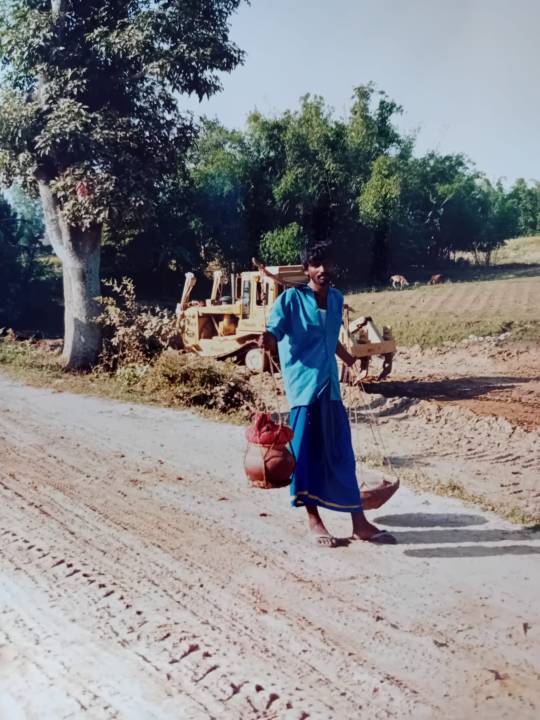

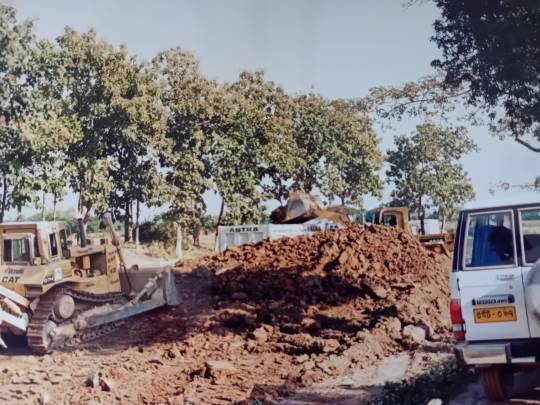
At the beginning of January I was called by the San Donato Head Office office, where SNAMPROGETTI proposed my return to Saudi e Al Jubail petrochemical project. I didn't intend to return to that country so soon. Therefore I asked if there were any alternatives, but was told that at that moment it was ''Saudi or nothing''. I said thanks, it will be for another time.
Faced with the ''either Al Jubail or nothing'' I accepted the invitation for an interview first, and than for the assignment by BONATTI Parma. They had a project in Bangladesh to propose for me. To tell the truth, it was an unusual project for BONATTI. The rehabilitation of a road, specifically the 84 km that linked Dinajpour to Panchagar, in the North of the country. The work was part of an aid package that the Italian Ministry of Foreign Affairs intended to implement in Bangladesh through the Italian Cooperation Fund.
Before my departure to Bangladesh, Mr. Romitelli (Deus ex Machina of BONATTI) told me:
''You have to come to Parma for a couple of days to familiarize yourself with the ROADCALC software, the tool with which the project's accounting will be done''.
''Ok fine – I replied – I'll be there. In fact I went to the BONATTI Parma headquarters, I met with their IT Manager who took me to his office, throw a package with 5 CDs on the desk, and told me:
That's it, take them and .............now you can go!
Thanks a lot Sir - I answered -and goodbye!! And this was the ''training course'' BONATTI gave me in order ''familiarize myself with the calculation program''.
JOURNEY TO BANGLADESH I left Italy in early October, and it was still hot when in Rome Fiumicino we were taken by airport shuttle bus under the DC10 of BIMAN, the national airline of Bangladesh. The flight schedule included a stopover in Dubai, and than would arrive in Dakha after another 5 hours. I noticed some alpinists boarding the plane with us: judging by their clothes and boots they were wearing, their final destination was undoubtedly the Himalayas. Nevertheless, I thought, why wearing such heavy clothes in warm Rome's autumn?
Again: why had they brought crampons, ropes, ice axes and other climbing items into the cabin (perhaps to save on extra baggage?)
Anycase we had been sitting inside the plane for almost one hour, but still takeoff did not take place. Finally the Captain spoke on the loudspeaker and told us that the loading service was unable to introduce a pallet with some items into the hold. To entertain us while we waited, the cabin crew distributed a snack: a toast bread stuffed with one slice of cheese and a leaf of green salad! (And a glass of water.....). ''What a great start......'' I told myself'' - but the best was yet to come. After more than an hour, the loading operations were completed, and the pallet was left on the ground. Than the plane took off. Normal takeoff, aircraft at flight altitude. About an hour passed, and from the window I saw some snow-capped mountains: I wondered what chain it could have been, given that a normal route to the Middle East should not have flown over snow-capped mountains in that period. Another hour passed, and the Captain kindly informed us:
We like inform passengers that we have begun the descent to Frankfurt airport, fasten your seat belts…etc…etc.
But ......why Frankfurt? I ask the stewardess – weren't we supposed to go directly to Dubai?
Yes – she tells me – but then we were late and then it was decided to go to Frankfurt to pick up some passengers.
Ahh…ok….sure we're travelling on airplane? Not in a city bus?
She smiled and went away without replying........ With now the plane approaching the landing, Captain spoke again:
Hallo.......Here your Captain speaking - we were warned by Frankfurt airport control tower that the persistent fog does not allow landing at the moment, therefore we remain at altitude nearby awaiting for instructions. Another good half an hour passed like that, while we flew in circles over Germany. And than the ''Our Dear Captain' said:
''The Frankfurt control tower warns that no clear weather is expected in the next few hours, so it has been decided that we're continuing our flight to London Heathrow''. LONDON HEATROW!! If we continue like that.....next announcement could be ''we've turned left, we're going to New York!. Anycase after 45 minutes safely landed at Heathrow!. Some passengers boarded and than the stewardess announced the plane would take off for Dubai in a few moments. We reached Dubai and it was already the dawn of a new day, and we were told to desambark becasue of refuelling operation will take place. As usual, inside Dubai airport it felt like being at the North Pole: the temperature was 16 degrees, definitely too low for an airport lounge. Then, with another 5 hours flight, eventually we reached Dakha, our final destination: 27 hours had passed since we left Rome!! The customs and immigration formalities were pretty quick – I came out of customs and saw a guy hoisting my name up on a board: he was the driver sent by Company Branch. He took my luggage and we started walking inside the airport, when I saw a group of people who seemed to be accompanying a tall and big man – when we were close enough, I noticed his hair and thick gray beard, his tortoiseshell glasses. , the perfect cut dress: Gian Franco Ferre', one of the great names in Italian fashion! Someone later explained to me the reason for Ferre' visit to Bangladesh: in Dhaka there was a ''Free Zone'' where big foreign groups had invested large capital and where no taxes were paid locally, as long as local manpower were employed (Which naturally cost very little). In this Free Zone all the big names in Italian fashion were present: in addition to GF Ferre', there were Valentino, D&G, Versace and few others. An elderly and still attractive Italian Lady who I later got to know, was in charge to manage all the production laboratories.
DAKHA GUEST HOUSE It took us a couple of hours to get to the Guest House: Traffic in Dhaka is a nightmare not only for cars and buses, but because of thousands of scooters and bicycles. The company Guest House was the former Italian Embassy. Italian diplomatic corps had recently moved to an even larger and more luxurious villa. Gulshan, the embassy area of Dakha is of course the most luxurious within the city, with large villas surrounded by tropical gardens. When we arrived I was so tired that I got into the bed without having any breakfast at all. In reality I had lost track of time, and I wasn't sure whether it was morning or afternoon or whatever........ Any case, I slept until the following noon without interruption. I was woken up by the housekeeper, who told me that lunch was served. Once at the table I met my two new Italian colleagues: one of them was in charge of customs and personnel, the second was in charge of the logistics of the construction sites. They gave me some informations regarding the project, and we had an excellent lunch prepared by the Bengali chef. Company office was located on the villa ground floor. Three local employees were present, and greeted me at the time I entered. Educated Bengali people are very polite.
TRANSFER TO THAKURGAON
The next day I left for Dinajpur in a domestic flight: about an hour by plane with an unbearable stench caused by the grease that the locals spread on their hair to make it ''shiny''. Upon arrival, another driver was waiting to take me to Thakurgaon, 60 km away from Dinajpour airport. I thus had the opportunity to see the conditions of the road that was the subject of our project. Some sections were really in bad shape, with deep potholes and bumpy asphalt - more worrying were the conditions of numerous bridges we crossed the frequent rivers and swamps: there would have been work to do!
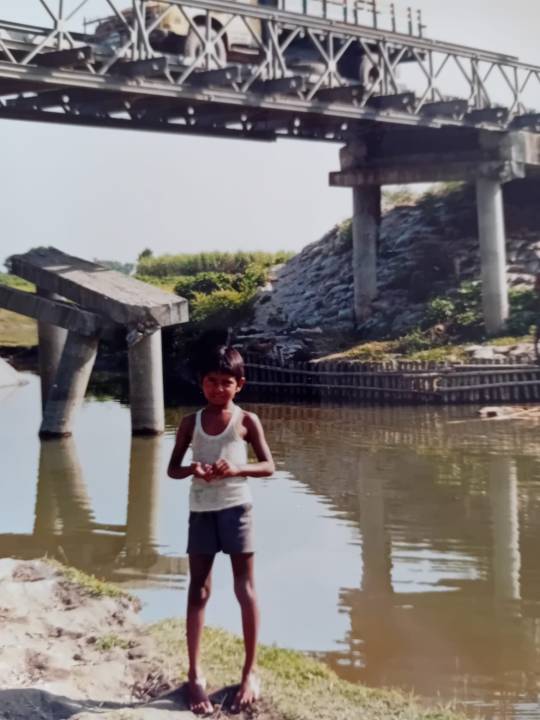
My driver was chewing ''paan'' (a preparation that combines betel leaf with areca nut, which turns the tongue and teeth red-brown - In Bangladesh, paan is chewed throughout the country from all classes and is an important element of the country's culture).
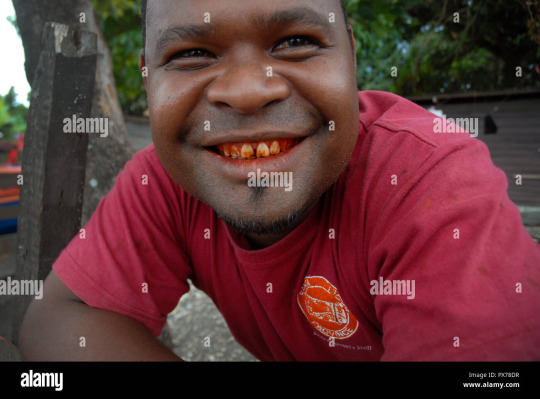
In the world majority of the countries people drive on the right lane. There are others where left lane driving is established. (UK and former colonies in general). And than there is Bangladesh where people drive in the middle of the road! When two vehicle from different direction meet, the challenge is always the same: to maintain the center of the road until the other one moves onto the road shoulder… We arrived in Thakurgaon, and I found out it was a fairly tidy little town. BONATTI had built a compound of brick houses which essentially consisted of a bedroom and a bathroom: much better than the usual prefabricated sheet metal containers! There was a canteen-kitchen building, and one for offices. A tennis court and basket ball playground was also provided. All in a well-kept garden of palm trees and tropical flowers. And of course a spacious workshop for the maintenance of construction equipment. The compound housed 12 Italian expatriates, plus a dozen Filipinos and locals who worked with us, or belongs to Works Management. It was lunch time, and so at the table I got to know my new colleagues, starting with the Construction Site Manager Mr. Coda, originally from Biella - Italy - a man with West Africa background. The cook was Bengali, but the food was Italian, albeit with some local influences. In the afternoon I went with the Site Manager for a tour of the areas where work in progress, and than to visit the area where an Italian technician was assembling a plant for the production of aggregates, gravel and sand.

A Virtgen was also expected from Italy, a machine capable of ''eating'' existing asphalt and recycling it. In short, the work was interesting, with a lot of activities to be carried out along the 80 km of the road - the equipment available seemed excellent, and the staff capable. Objectively there were enormous logistical problems: difficulties in supplying fuel and spare parts - practically non-existent telecommunications, but we need to consider we were in North of Bangladesh, not beside Abu Dhabi......
ITALIAN CATHOLIC MISSIONARY HOSPITAL
After the settling-in period, I was told by Site Manager to investigate on the possibilities of emergency response in the event of employee's accident-illness. We had learned that about 40 km from Thakurgaon there was a hospital run by Italian Catholic missionaries, lost in the immense rainforest. So one day I went there. It was not easy to find the hospital location, given the total absence of road signs. I was welcomed by Father Rodolfo Albanese, originally from the province of L'Aquila. A man in his '60, whose goodness of spirit and the vicissitudes passed in more than 30 years of Bangladesh could be read on his face. He introduced me to the nuns who collaborated in the community - in addition to the building used as a hospital and the church, the compound had a school, a building where trades such as carpentry and crafts in general were taught. There was of course a large vegetable garden, from which a great deal of sustenance was drawn for the community. Plus a poultry and rabbit farms. I met the three ''Sisters of the Immaculate Mary, all of them very elderly, unfortunately. I spoke with one of them, she was originally from Dalmine, a city of Bergamo province.
And tell me - Sister Angela asked - how is Italy doing? Do you have Coca Cola there? And actor Amedeo Nazzari, how is he?
Sorry Sister - I said - may I ask you when you been in Italy last time?
Well… you know… we sisters of the Immaculate Mary suppose to leave Italy for ever .....but Pope Montini, believing it was unfair, granted us a return ticket every three years of permanence here - I however – she added – whenever I receive the ticket I don't use it, and I always ask for a refund, so we can use the money obtained for good causes! Therefore I haven't returned to my country of origin since 1957........
Ohh well… this does you credit, Sister! Anyway yes, in Italy we have Coca Cola and Nazzari… well I think he is very old now!! (I didn't dare to tell her that he was dead......)
And how do you find yourself here, Sister?
Well here you see by yourself… life is very hard, we are in a Muslim country, but we are respected, the people are good to us. Of course there were more critical times, such as during the war of liberation from Pakistan - as good Christians we tried to help everyone, but the Pakistanis told us that we were helping terrorists, and the Bengalis that we were helping the enemy. It was very hard time for us!!! After a simple but good lunch, I said goodbye to Father Rodolfo and the Sisters, promising that we would do something for them, and that in case of need we would certainly turn to the hospital.
GRAVEL AND AGGREGATE. Bangladesh is such a poor country that it doesn't even have rocks. And without rocks one cannot produce gravel. So huge boulders of 4 or 5 cubic meters are imported from India which are than transformed into gravel by women equipped with a hammer and chisel. There was one such kind of ''crushing plant'' in Thakurgaon, and the women who worked there were paid 2 USD per day. Under the scorching tropical sun, there wasn't a single one who suffered from excess fat........

When they saw our gravel crushing plant, they did not hide their anxiety at being deprived of their job, and therefore a source of livelihood. We assured them that we intended to use the gravel only for the project, without selling it on the local market.
ANTI-MOSQUITO Bangladesh land is almost perpetually under water: floods are frequent, and stagnant water favors the proliferation of mosquitos. The local system to fight mosquitos involves the whole family, the oxen and the cows. The excrements of these animals are collected by children, and then mixed into a round pyramid shape with clay, straw and dry branches - stuck to the walls outside the houses, with a stick in the center of it - when the dough falls to the ground it means that it is ready for use. Some families make commercial use of it, in the sense that part of the production is put on sale on a roadside stall. During the night the anti-mosquito is set on fire, and it burns slowly, releasing an acrid and smelly smoke into the rooms - a smoke and a stench that mosquitoes cannot stand, leaving the occupants of the homes to sleep peacefully.

FOX BAT A afternoon the warehouse guy call us: a fox bat had just landed in in front of the warehouse, and it didn't seem capable of flying. We went to see, and we noticed that fox bat was a very large specimen, the wingspan must have been more than two metres. It had enormous black wings attached. Bat was wounded on the right wing, and blood was dripping onto the ground. I called the nurse, who brought everything needed to disinfect and treat the bat. It looked scared, and the nurse gave him a calming injection. Bat stayed with us for a week, every now and then I went to visit him; it ate an industrial quantity of mangoes and bananas. At the end of the week the bird made some flight attempts, and after a couple of turns over the warehouse it left and returned to the forest.
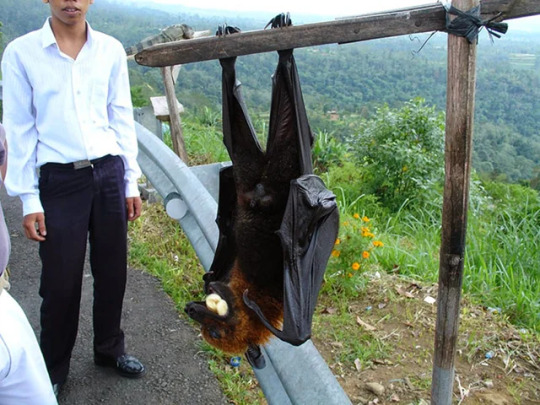
BUSH SURVEY Every now and then I accompanied the surveyor to carry out measurement activities. On a very hot afternoon, after the usual torrential rain, we were close to a half-collapsed bridge, one of those that we would have had to rebuild, and on which traffic was currently flowing in alternate directions. We entered the tall grass, the local surveyor with his assistant were ahead of me by about ten metres, when suddenly they came back running and shouting ''SNAKE .....SNAKEEEE.........''!! We all started running backwards along the path barely visible in the thick vegetation. When we arrived at a layby, we stopped, out of breath.
What did you see – I ask.
A big snake Sir, very big!
Ok – I told him – let's go back there
No Sir, it can be very dangerous, Sir!
Take the machete from the pick up and then let's go and see. We retraced our steps, advancing cautiously through the tall grass. The faces of the two Bengalis were ashen. As we approached the point where they had seen the snake, they slowed down more and more. Finally we saw what had scared the two boys to death: a skin of what an expert would later tell us was a Python reticulatus, the longest snake in the world, as well as being the longest of all reptiles. The Bengalis began to laugh, that nervous laugh you get when you have escaped danger. We recovered the skin, and took it into town to the local Wildlife Office.

LOCAL DRIVING LICENCE I had an appointment for the exam to obtain my local driving license. I was sitting in the office of Police Chief, a fat guy, who, using a long, thin bamboo stick, was pointing out signs with Bengali writing on the room wall.
What does this mean? - he said.
I don't know, Sir – I replied
And what does this mean?
I don't know, Sir.
He looked at me sideways – and what does this mean?
Again Sir, I don't know….
Let's make one last attempt: what does this say – the officer asked me, pointing to a doodle written in green.
I'm really sorry, Sir, I don't know......
But you - said the Officer - can you read the characters written in Bengali?
No Sir.
Then why didn't you tell me?
You didn't ask me, Sir. He collapses into his chair, behind the desk - then all in one breath, without looking at me, he said:
Give me 1,000 Taka (9 euros) -I put the bills on his table. -He stucked my photo on a beige booklet, he affixed a couple of stamps and then while giving me the driving license he said:
Be careful while driving – good bye! I had passed the exam.
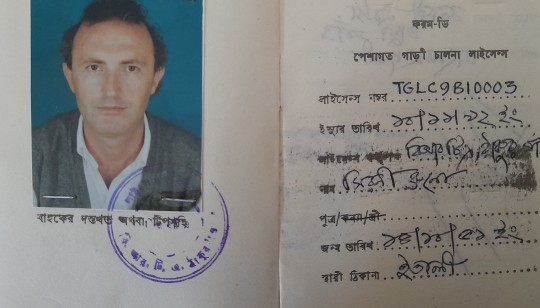
SECRETARY Our secretary was a small girl, with delicate features, prettier than the average Bengali woman. She was in her 30 but she looked less than 20, and she had been married for sometime. One day I asked her how many children she had and she replied:
Three Sir, a boy and two girls - I got the 10 year old boy from my husband, then he left and I haven't known anything about him for years.
But ......beg your pardon ....your daughters ...who's the real father?
I don't know Sir – she replied – at night we all sleep in a large room, we don't have electricity and it's dark – so I don't know exactly who the father of the two girls is. Too sad......
HINDU TEMPLE VISIT. I had learned of the existence of the very important Hindu Kantajewm temple, around 40 km away from Thakurgaon. Kantanagar Temple, commonly known as Kantaji Temple or Kantajew Temple in Kantanagar, is a late medieval Hindu temple near Dinajpur. Kantajew Temple is a religious building built in the 18th century. The temple belongs to the Hindu Kanta or Krishna and this is the most popular with the Radha-Krishna (memorable love assembly) cult in Bengal. This temple is dedicated to Krishna and his wife Rukmini. Built by Maharaja Pran Nath, its construction began in 1704 AD. and ended during the reign of his son Raja Ramnath in 1722 AD. It is an example of terracotta architecture in Bangladesh and once had nine spiers, but all were destroyed in an earthquake in 1897. The driver took me there in a Friday afternoon. The temple was beyond a marshy area and a man with a rowboat ferried us to the island. Taking advantage of the relative isolation, a small community of Hindu fishermen and farmers who had settled there were little safer, in a country where 99% of the population is Muslim. I met a group of Hindu pilgrims from a Dakha school, visiting the temple. And I spoke to the ''Guru'' of the temple itself, a small, elderly man with a face lined with a thousand wrinkles. In truth the temple was very beautiful and large. It was a beautiful afternoon, and I retain the memory of an enchanted and timeless place, where miserable human events lost their meaning.
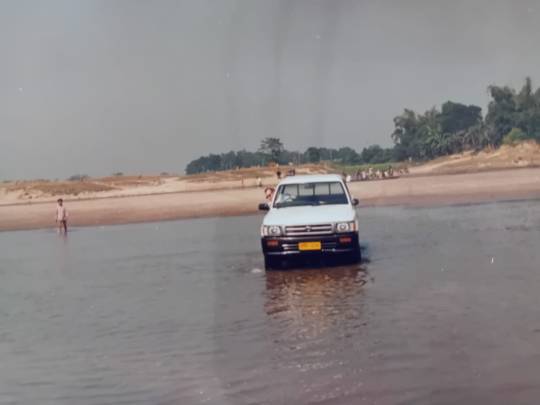
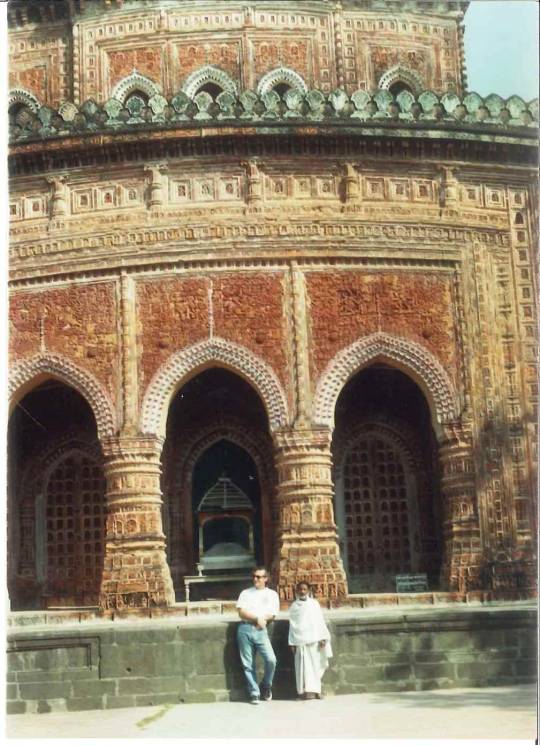
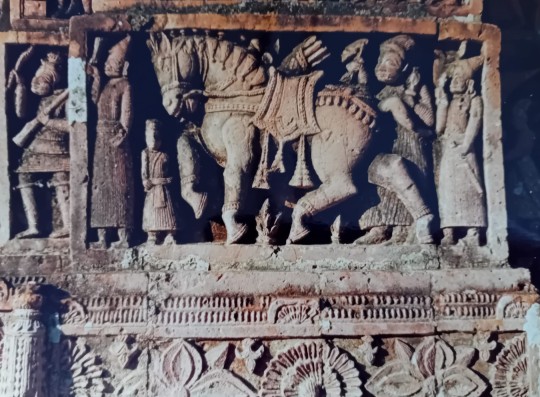
CHOLERA There is an unwritten law in the country: up to 500 deaths a day, the press and television report the news as ''dysentery''. Between 500 and 1000 deaths per day the news is given as a ''possible cholera epidemic, the case investigations are underway''. Starting from a more significant number of daily deaths, the area of infection is subjected to lockdown, in an attempt to limit the proliferation of the disease. In the country there are thousands of deaths per year from these epidemics.
AMBULANCES As a country at the bottom of the list of underdeveloped states, Bangladesh was and is the object of continuous aid and donations from International Organizations. In 1992, the Croix Rouge of Belgium collected enough donations to purchase two modern Mercedes ambulances to ship to Bangladesh. Arriving by ship at the port of Chittagong, the two ambulances could not be unloaded. The local customs asked the Belgian Croix Rouge to pay the import taxes. The Belgian Ambassador, present at the port and waiting to attend the ceremony of delivery of the ambulances to the local Red Crescent, realizing that the problem was not solvable, ordered the ambulances to be brought back to Belgium.
TETULIA A Friday, a day of rest in Bangladesh, I left for an excursion to Tetulia. Also known as "The City of Dreams", Tetulia is a city in the far north of Bangladesh - tea, orange and pineapple cultivation is abundant in its surroundings and is located on the Indian border with Darjeeling. It was a wonderful day, and from the heights of the city I saw the snow-capped Kanchenjunga shining in all its beauty, the third highest mountain on earth, less than 100 km away as the crow flies. In addition to the shining Himalayan mountains, I also saw the very high fence that the Indian Government had installed along the border to try to prevent the illegal immigration of Bangladeshis into India. In 1992, India launched an operation called 'Push Back' in an attempt to repatriate many of the 20 million-plus Bangladeshis living in India illegally.

Mr. CODA. A morning, after breakfast I went to the office: I needed to speak to the Site Manager, but Mr. Coda had not yet arrived. I waited in vain for his arrival for about hour, then I asked the secretary-factotum - a very smart Bengali guy - to accompany me to the site manager's house. We knocked in vain and then called the cleaning girl who had a passpartout key. Once the lock was opened, the door resisted because Mr. Coda's body was on the ground against it. The secretary heard his heartbeat and gestured to me with his thumb: he's breathing, he's still alive! We put him on the bed, the nurse had arrived and was carrying out some maneuvers to try to resuscitate the poor guy. In the end Coda reopened his eyes, he was obviously dazed but managed to blurt out a few words like ''my heart… my heart''. A nitroglycerin tablet was placed under his tongue, in the meantime I had gone out to call the driver and have the Toyota prepared to transport Mr. Coda to the Italian Missionaries' hospital. So within a few minutes we placed the poor guy in the Toyota with the seat reclined. I took a seat next to him and we left for the hospital. The 40 km that separated us from the hospital were traveled at the maximum speed allowed by the condition of the road and traffic. When we arrived in front of the hospital Father Rodolfo was out there. He saw Coda's suffering face and said:
Poor thing! What happened to him?
I think he had an heart attack Father!
Ohh…poor guy…eeeehh…I mean…did you bring any medicine with you?
………………….. I was speechless…….
Sorry Father… the medicines… to tell the truth we… thought that the medicines… you had them here… it's a hospital here no?…
Noo……noo…here we just have some sedatives……and something for colds and flu….
So we came all this way for nothing?
No why? We can pray together…….
Thank you Father……. We retraced our steps, while Mr. Coda seemed to be doing a little better. Before leaving the base, I had asked the secretary to call Dhaka and inform the Branch of what had happened. When we were back in Thakurgaon, Branch had called to say that an air ambulance SOS Medical from Singapore had been alerted, and that it would arrive at Dhaka airport the following afternoon to evacuate the patient. The problem was to transport Coda to Dhaka, 700 km away. On the plane it would have been dangerous for a person with an ongoing heart attack. It was decided to leave immediately for Dhaka with the Toyota, me, Coda and the driver. It was a difficult journey, 700 km of very bumpy state roads, with the crossing of the Brahmaputra river by locals ferry, a small boat made of colored wood and sheet metal where sixty people and two cars were piled up. The crossing took almost two hours, and takes place by cutting the river diagonally, because the current does not allow otherwise. After a journey of over 15 hours, we arrived at Dhaka Airport in the afternoon. Our local customs officer was waiting for us and had already negotiated permission to access the plane's parking area by car. Mr. Coda was quite well, considering his state of health and the long difficult journey from Thakurgaon. The Singaporean doctor and nurse welcomed him on board the plane which was a real flying operating room. They checked his health, put him to bed, immediately hooking him up to various machines. We said goodbye to Coda, wishing him good luck. The next day I returned to Thakurgaon by airliner, leaving the driver the ''pleasure'' of returning alone.
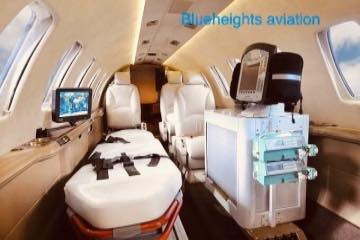
After a few days, we were informed that Coda had passed the critical phase, and once he had fully recovered he would return to Italy on an commercial airliner. We were requested to send his belongings to Dhaka.
PROMOTION I was therefore promoted to the new Construction Site Manager, I must say to the happiness of all the employees, both expatriates and especially locals, who did not take kindly to my predecessor's frequent outbursts. One of the first measures I took was the dismissal of the cook and the promotion of his deputy. It happened one day just before lunch - I saw that Bengali cook returning from his shopping with a motor rickshaw. On the seat next to him, from a distance, I couldn't make out clearly, but I thought I saw bags of cement! I left the office and approached the canteen, noticing that the cook was unloading some bags of cement, yes, but they contained rice, flour, grains!
But you've gone crazy or what??? ! I told the cook, already annoyed.
Why Sir? Why are you telling me this? He answers me with the most surprised face
Why?? you're transporting the stuff that WE eat in bags where before there was cement! And you ask me why I get angry??
But Sir……I eat this stuff too, not just you….
You can poison yourself as you like, but you can't poison us!! Okay, let's go to the kitchen, while we're on the subject I want to do an inspection. We went into the kitchen, and what I saw took away all my doubts:
Abdulkharim…come to the office…immediately! When we were in the office, I called the secretary and in front of the cook I ordered him to prepare the letter of dismissal and all his entitlements - I wanted him out of the camp by evening. In the afternoon Abdulkharim again asked to speak to me.
Tell me quickly, I don't have time to waste with you…
Sir, I'm very sorry Sir……and in any case you will appoint the assistant chef as the new head chef in my place.
And then?
Well you don't know what he does when you Italians are absent and can't see! -What does he do?
He takes one of the girls into the storage room and then………
Really??
Yes Sir….
Well, then in this case I will give him a raise… goodbye.
Well…Sir…
Fatimah accompanies this gentleman out.
BENGALI MINISTRY OF TRANSPORT VISIT The rehabilitation of the Dinajpour – Panchagar road was a project of National interest. One day a visit by a government delegation led by the Minister of Transport was announced. I got in touch with the Dhaka branch, and informed them about the visit. They were already aware of it, and they told me that the commercial attaché of the Italian Embassy in Dhaka, Mr. Colombo, would also participate in the event. On the day of the visit everything was ready to worthily receive the Minister. But with my desappointment, the Italian Embassy chose a ''low profile'' and denied permission for Mr. Colombo to reach Thakurgaon and attend the Minister's visit. I therefore found myself alone in front of a large delegation from the Ministry, whose members all had questions to ask and curiosities to satisfy. Nonetheless, the visit went well: the Minister was satisfied with what he had seen, and was impressed by the crushing plant (a premiere in the country). The visit ended with a reception at our compound, during which traditional Bengali dishes were served.

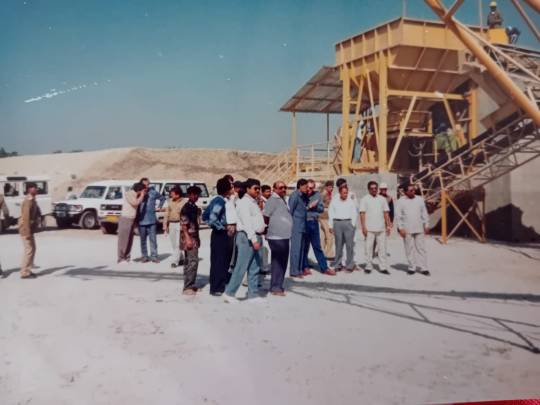
The next day I was informed by the secretary that in the evening, on the state channel, the news would be broadcasting a report on the Minister's visit - so I saw myself on TV, and I must admit that it wasn't bad at all. Following the reportage, sometimes in the shops or cafeterias of Thakourgaon I was ''pointed out'' by someone who had seen me on TV. However, the lack of participation on the part of BONATTI, the Italian Embassy, and in general the news coming from Italy, where the Company was heavily investigated by the Judiciary, had generated a sense of abandonment and distrust in the local staff.
DIESEL We had enormous logistical difficulties, and one of the most critical was the continuous lack of diesel and fuel in general. The supply took place through tankers which sometimes arrived from very far away. There was a particularly difficult period, in which many construction operations had to be suspended due to lack of fuel. One day we were notified that a tanker with 33,000 liters of diesel had left from Dhaka – 700 km away – towards Thakurgaon. The wait became exhausting, especially due to the obligation to sip the remaining diesel. After 2 days we were informed that in a village about 30 km from Thakurgaon a tanker - probably ours - had had an accident. We left immediately to go and check, once we arrived on site we found that it was the tank intended for us that had had the accident. The driver, probably tired from the long journey, had fallen asleep, the truck had ended up in the drainage ditch next to the road, and had tilted onto its side. The usual crowd that had appeared out of nowhere had gathered to witness the accident, and everyone watched impassively as the fuel leaked from the open manholes of the tanker and flowed into the drainage ditch and then towards the nearby river! Nobody did anything to stop the disaster, and that was precisely the reason why Bangladesh was the country it was: not even in the face of accidents, spreading infections, natural disasters, these people moved a muscle! They simply watched helplessly. The driver was unharmed, but in shock. Luckily we found an old crane and within an hour we managed to right the truck – half the fuel load had gone into the river, unfortunately. The vehicle was damaged and unable to continue, we left a couple of people to guard the tank. The next day we sent another tanker to transfer the remaining diesel, and then finally reach the Thakurgaon field.


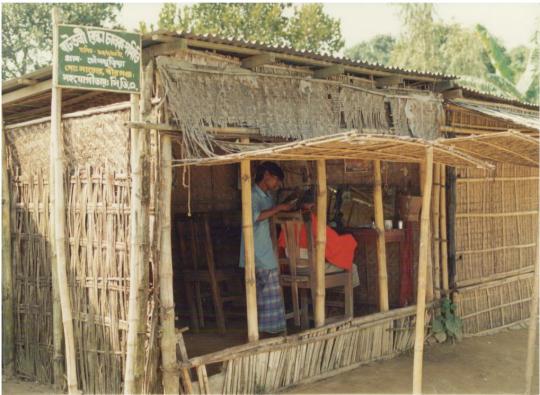
2 notes
·
View notes
Text
Funding Available for Buses and Bus Facilities Programs
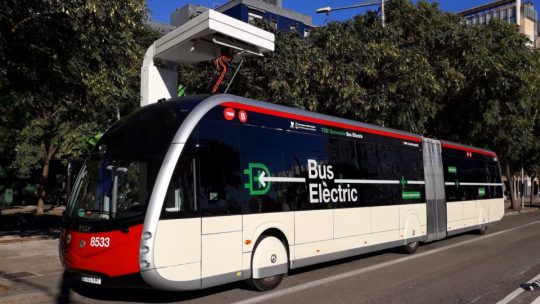
The U.S. Department of Transportation (DOT) Federal Transit Authority (FTA) Low or No Emission Vehicle (Low-No) and Buses & Bus Facilities Program are offering large grants for the purchase or lease of zero-emission and low-emission transit buses, including the acquisition, construction, and leasing of required supporting facilities such as recharging, refueling, and maintenance facilities.
Projects should support the transition of fixed-route bus service to the lowest polluting and most energy efficient transit vehicles. Eligible projects under the Low-No Program (no maximum ask) include:
Purchasing or leasing low- or no-emission buses
Acquiring low- or no-emission buses with a leased power source
Constructing or leasing facilities and related equipment (including intelligent technology and software) for low- or no-emission buses
Constructing new public transportation for facilities to accommodate low- or no-emission buses
Rehabilitating or improving existing public transportation facilities to accommodate low- or no-emission buses
Eligible projects under the Buses & Bus Facilities Program (up to $3.9 million) include:
The replacement, rehabilitation, and purchase of buses, vans, and related equipment, and;
The construction of bus-related facilities, including technological innovations to modify low or no emission vehicles or facilities.
Eligible applicants for both programs include direct or designated recipients of FTA grants operating fixed-route bus serviceStates, local governmental authorities, and Indian Tribes. Proposals for projects in rural areas must be submitted as part of a consolidated state proposal. States and other eligible applicants also may submit consolidated proposals for projects in urban areas. A 15% match is required for leasing or purchasing a low or no emission transit bus. A 10% match is required for leasing or acquiring low- or no-emission bus-related equipment and facilities.
Applications for both the Low-No program and the Buses & Bus Facilities program are due by April 25, 2024.
For more information about how Sustainable Strategies DC can help your community with an FTA Low-No or Buses & Bus Facilities application, please contact Sarah Marin at (202) 308-7125. For additional information on other funding opportunities, please click here for our website.
1 note
·
View note
Text
18 août :
Journée transport pour rejoindre Lillehammer, une petite ville au Nord d'Oslo. J'y arrive après 6 heures et 3 bus. 1er hostel et lit après 9 jours, pour fêter ça c'est pizza et bière. J'ai des larmes aux yeux. Pourquoi il faut se faire du mal pour apprendre à apprécier le peu ?
19 août :
Visite du musée à ne pas rater de Norvège, le Maihaugen. Édifié par un dentiste de la ville début XXe qui, en allant visiter des patients dans des fermes, s'est rendu compte que le mode de vie et d'habitations risquait de disparaître avec l'industrialisation. Il a décidé donc de déplacer (et non de reproduire) des villages/fermes qui sombraient dans l'abandon dans son musée. Son entreprise se poursuivant jusqu'à aujourd'hui, on trouve dans ce musée des habitations du XVIe jusqu'à des maisons high-tech, toute richement décorées. Le tout en plein air et on visite le parc en se promenant. J'y passerai 4 heures sans voir le temps passer.
Puis train jusqu'à Oslo où je logerai 2 nuits chez un hôte trouvé sur couchsurfing, première expérience pour moi avec ce système.
Je fais donc connaissance de Abu, ingénieur software indien venu à Oslo pour le travail il y à 7 ans et qui s'y ait plu. On s'entend très bien, il nous fera a dîner les 2 soirs des lentilles (excellentes!), j'aurais ma chambre et je peux même faire ma lessive. Du luxe.
20 août :
Visite de Oslo. A part quelques bâtiments comme le palais royale ou la cathédrale, la ville est très moderne avec des quartiers sortis du futur. Ballade agréable mais c'est la première fois que je visite une capitale européenne sans y apercevoir son histoire et son passé via son urbanisme, pas de "vieux quartier" dit autrement. Abu me rejoint en début d'aprèm pour me montrer des coins à visiter et pour une bière.
21 août:
Micha me rejoins à Oslo en voiture et mon périple européen en solo s'achève ici. Ca me fait plaisir car mon ami imaginaire dans ma tête commençait à être inintéressant. Il fait beau et on prend direct la route vers l'ouest, avec une pause à l'église xx pour manger. Je découvre à cette occasion la cargaison de fromage, charcuterie, vin, rhum, etc que Micha a ramené. Je retiens mes larmes.
Arrivés au parking du Kjeragbolten à 18h00 (30 € de vol) on court vers le fameux caillou suspendu en haut d'une faille. On y monte pour les photos, 800m au dessus vide qui finis dans le fjord. Puis on se trouve un coin pour la tente avec vue panoramique sur ce même fjord. Il fait beau et on est sublimés par la beauté du paysage.
22 août:
Réveil dans les nuages qui offrent une autre vue. Retour à la voiture et direction le Preikestolen. 25 € de parking et 1,5h plus tard on arrive à cette plateforme carré qui chute direct avec des parois lisses à 600m dans le fjord. Incroyable cette nature. Par contre c'est Eurodisney niveau affluence. On part donc faire une ballade sur les falaises à coté où, comme par hasard, on y croise personne. Puis le temps de poser la tente, tout le monde est partit de la plateforme et on est enfin seul. C'était en tout cas l'idée. Mais un groupe de 40 jeunes en sorte de "colo" foutait un bordel pas possible. Je n'aurais réussit à en balancer que 3 par dessus le rebord, trop nombreux pour tous les achever. Bref, ils ont finis pas partir et laisser la nature tranquille, et nous avec.
2 notes
·
View notes
Text
From Static to Smart: Why Agencies Are Switching to Qryde’s Microtransit Software in 2025
Public transportation is entering a new age of personalization and flexibility. In 2025, more transit agencies are shifting away from rigid, fixed-route models toward dynamic, rider-responsive systems. At the heart of this transformation is Qryde’s Microtransit Software, a robust platform designed to help agencies serve more people—more efficiently—with fewer resources.
Solving the "Transit Desert" Problem
Traditional bus routes don’t work for every community. Low-density suburbs, rural zones, and emerging industrial areas are often left disconnected. Microtransit software offers a smarter way: flexible, shared rides that respond to real-time demand.
Qryde empowers agencies to deploy app-based, zone-specific shuttles that operate like ride-hailing but with public system oversight. This fills the mobility gap without needing large-scale infrastructure investments.
Technology That Adapts in Real Time
The power behind Qryde’s platform lies in its intelligent routing and automated dispatch features. It adapts vehicle assignments and routing decisions minute-by-minute, reducing wasted trips and improving on-time performance.
Platform highlights:
Cloud-based, centralized control panel
AI-powered demand mapping
Passenger tracking and notification system
Fleet optimization for peak/off-peak shifts
Agencies can customize zones, set service hours, and add new vehicles without rebuilding their system from scratch.
Budget-Friendly and Scalable
In an environment of tight budgets, Qryde delivers high-impact service with minimal costs. By replacing underperforming routes with on-demand microtransit, agencies cut operational expenses while increasing accessibility.
Even better—vehicles used for microtransit can also be scheduled for paratransit services or trips via NEMT fleet providers, creating a shared resource pool that works smarter, not harder.
A Data-Rich Decision-Making Tool
With Qryde, every ride is a data point. Agencies gain access to real-time analytics on:
Rider demand hotspots
Trip completion rates
Vehicle utilization
Rider feedback and behavior
This allows for evidence-based planning, continuous improvement, and stronger reporting for funding applications.
Eco-Friendly Urban Mobility
Qryde helps agencies reduce emissions by eliminating unnecessary miles and supporting electric vehicle scheduling. As more cities adopt climate goals, microtransit becomes an environmentally sustainable solution that also meets practical needs.
Build the Future of Public Transit
Qryde’s microtransit software is helping cities and rural communities alike adapt to 2025’s mobility challenges with tech that’s smart, inclusive, and easy to deploy. Whether you're running a small pilot or redesigning regional mobility, Qryde is your partner for modern transit innovation.
Learn more or schedule a demo at Qryde.com.
#paratransit software#nemt fleet#public transportation software#paratransit scheduling software#nemt fleet providers#paratransitsoftware
0 notes
Text
The Ultimate Guide to SpotBus: The School Bus Driver App with Turn-by-Turn Navigation
In today’s fast-paced world, ensuring the safety and efficiency of school transportation is more critical than ever. Enter SpotBus, a revolutionary school bus driver app with turn-by-turn navigation, designed to transform the school transportation experience. Let's explore how SpotBus is reshaping student transportation with its advanced features and capabilities.
Streamlined Navigation for School Bus Drivers
At the heart of SpotBus is its robust turn-by-turn navigation system. This feature ensures that school bus drivers can navigate routes with precision, avoiding traffic and minimizing delays. The navigation system is tailored specifically for school buses, taking into account the unique needs and restrictions of school transportation.
Simplified Onboarding and Offboarding of Students
SpotBus makes the onboarding and offboarding of students seamless and efficient. The app provides a digital log that tracks every student getting on and off the bus, ensuring that no student is left behind. This feature enhances the overall safety and accountability of the transportation process.
Comprehensive Trip Inspection for School Buses
Safety is paramount in school transportation, and SpotBus prioritizes it through its comprehensive trip inspection feature. Before starting the route, drivers can conduct a thorough inspection of the bus, logging any issues directly into the app. This ensures that all potential problems are addressed before the journey begins, maintaining high safety standards.
Track Students on School Buses with Live GPS Tracking
Parents and school administrators can breathe easy with SpotBus’s live GPS tracking feature. This allows real-time tracking of the school bus, providing peace of mind and ensuring that everyone knows the exact location of the bus at all times. The live GPS tracking feature is especially useful during emergencies or unforeseen delays.
Enhance Student Safety with Live Tracking
SpotBus goes beyond just tracking the bus; it also tracks the students on board. Each student’s location is monitored from the moment they board the bus until they safely disembark. This live tracking of students adds an extra layer of security, ensuring that parents and school officials are always informed about the students' whereabouts.
Efficient Management with Student School Bus Tracking
The student school bus tracking feature of SpotBus is designed to make managing school transportation more efficient. School administrators can access detailed reports and logs about each trip, helping them to make informed decisions and improve transportation logistics.
Real-Time Updates with Live Tracking School Bus
With live tracking school bus updates, SpotBus keeps all stakeholders informed about the bus’s progress. Parents can receive real-time notifications about the bus’s arrival times, delays, and any changes in the schedule. This transparency fosters trust and keeps everyone in the loop.
Conclusion: Why SpotBus is the Future of School Transportation
SpotBus is more than just a navigation app; it’s a comprehensive solution for modern school transportation challenges. By integrating advanced features like turn-by-turn navigation, student tracking, trip inspection, and live GPS tracking, SpotBus ensures a safer, more efficient, and transparent transportation experience for everyone involved.
Adopt SpotBus today and join the revolution in school transportation. With SpotBus, you can rest assured that your students are in safe hands, navigating their way to and from school with ease and security.
#AI School bus routing software#School Bus driver app#School bus driver app with turn by turn navigation#on boarding and off boarding of students#Trip Inspection for school bus#Track students on school buses#Live GPS Tracking#live tracking school bus#live tracking students
0 notes
Text
World Institute of Technology—[WIT], Gurgaon
World Institute of Technology (WIT), Gurgaon, established in 2007-08, is a private engineering and technology institute situated in Sohna, near Gurgaon, Haryana. The institute was founded by the Baljeet Singh Education Society with the aim to provide quality technical education and produce skilled engineers, entrepreneurs, and industry-ready professionals.
Location and Campus
The institute is located on the Sohna-Palwal Highway (NH-71B), about 8 km from Sohna town and approximately 24 km from Gurgaon city. Spread over 18 acres, the WIT campus is well-planned and environmentally conscious, offering a peaceful and academically encouraging atmosphere away from the distractions of city life.
The campus includes modern academic blocks, well-equipped labs, a central library, and green spaces. It is designed to foster academic focus while ensuring physical, cultural, and recreational development for students. It is known for being a Green Campus, promoting eco-friendly practices.
Academic Programs
WIT offers a range of undergraduate, postgraduate, diploma, and vocational programs, primarily in engineering and applied sciences.
Undergraduate Programs (B.Tech):
Computer Science & Engineering (CSE)
Electronics & Communication Engineering (ECE)
Mechanical Engineering (ME)
Civil Engineering (CE)
These programs focus on core technical subjects, soft skill development, and practical exposure through labs, workshops, and industrial training.
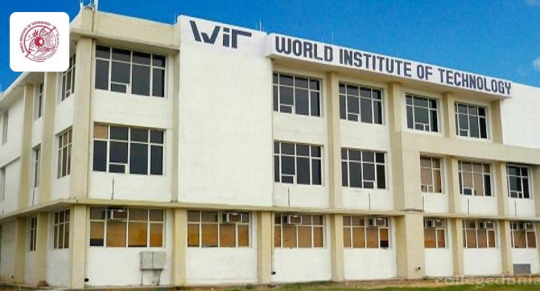
Postgraduate Program (M.Tech):
M.Tech in Electronics & Communication Engineering
Admission is generally through GATE or merit-based evaluation.
Diploma Programs:
Diploma in Mechanical Engineering
Diploma in Civil Engineering
These 2-3 year programs are ideal for students seeking practical and industry-specific skills post high school.
Vocational Programs (B.Voc):
Agriculture
Solar Technology
Public Services
Medical Lab Technology
Hospitality and Tourism
These programs are tailored to equip students with job-ready skills and real-world training in emerging industries.
Affiliations and Approvals
WIT is:
Approved by AICTE (All India Council for Technical Education)
Affiliated with Maharshi Dayanand University (MDU), Rohtak)
Recognized by the Haryana State Board of Technical Education (HSBTE)
These affiliations ensure adherence to academic standards, curriculum relevance, and regulatory compliance.
Infrastructure and Facilities
The institute offers a well-equipped, technology-enabled environment for both academics and extracurricular activities. Facilities include:
Central Library: With over 25,000 books, journals, e-resources, and access to digital learning networks.
Computer Labs: Updated with latest software and high-speed internet.
Engineering Labs: Dedicated labs for mechanical, civil, electronics, and communication engineering.
Wi-Fi Enabled Campus: High-speed internet connectivity in academic blocks and hostels.
Hostels: Separate facilities for boys and girls, with furnished rooms, 24/7 security, mess, and recreational spaces.
Sports Grounds: Cricket, football, volleyball, basketball, badminton, and indoor games.
Cafeteria and Mess: Hygienic and nutritious meals with multiple cuisine options.
Medical Facilities: On-campus clinic with tie-ups for emergency medical services.
Transportation: Bus services covering major routes in Gurgaon and neighboring areas.
Faculty and Learning Approach
WIT’s faculty comprises experienced academicians and industry professionals who focus on interactive learning, hands-on training, and student mentoring. Emphasis is placed on developing:
Analytical and problem-solving skills
Communication and leadership qualities
Practical knowledge through live projects and workshops
The curriculum is aligned with industry needs and regularly updated to reflect technological trends.
Student Life and Co-curricular Activities
WIT encourages holistic development by promoting co-curricular and extracurricular participation through:
Technical clubs and coding societies
Robotics and innovation cells
Cultural societies for music, dance, drama, and fine arts
Entrepreneurship Development Cell (EDC)
Annual tech fest, cultural programs, workshops, and guest lectures
Events like debates, fashion shows, hackathons, and inter-college competitions are regular features that enhance student engagement and confidence.
Placements and Career Support
WIT has a dedicated Training and Placement Cell (TPC) that works on skill development, industry connections, and student readiness for recruitment. Services provided include:
Resume writing and interview preparation
Personality development sessions
Mock interviews and aptitude tests
Internships and industrial visits
Key Recruiters Include:
Infosys
Wipro
TCS
Tech Mahindra
Cognizant
L&T Infotech
IBM
Syntel
QBE Tech
The average package ranges from ₹2.5 LPA to ₹4.5 LPA, while the highest package recorded crosses ₹10 LPA for certain tech roles.
Internships and project-based training are encouraged from the second year onward to improve employability and practical exposure.
Scholarships and Financial Aid
WIT offers several scholarship schemes based on:
Academic merit
Economic background (EWS students)
SC/ST/OBC categories
Sports or cultural achievements
These scholarships reduce the financial burden and encourage bright and deserving students to pursue quality education without compromise.
Why Choose World Institute of Technology, Gurgaon?
Well-connected Location: Close to Gurgaon with peaceful surroundings for focused study.
Affordable Education: Moderate fee structure with scholarship options.
Industry-aligned Programs: Courses crafted to meet current and future job market demands.
Modern Facilities: Labs, hostels, sports, and digital classrooms to support all-round development.
Placement Focused: Strong support in grooming students for job opportunities.
Practical Exposure: Workshops, internships, live projects, and vocational training.
Holistic Student Life: Balanced focus on academics, skills, wellness, and extracurriculars.
Conclusion
World Institute of Technology (WIT), Gurgaon is a rising private institution in Haryana’s educational landscape. With its balanced mix of academic excellence, modern infrastructure, and industry readiness, WIT offers a robust foundation for students aiming to build careers in engineering, technology, and applied sciences. It caters especially well to students looking for affordable yet quality education with strong employability outcomes. The institute continues to grow in reputation and aims to emerge as a center for innovation and technical leadership in the coming years.
#WITGurgaon#WITSohna#EngineeringCollege#PrivateEngineeringCollege#CampusVibes#StudyInGurgaon#CollegeLifeIndia#EngineeringLife
1 note
·
View note
Text
Enhancing Efficiency in Education: The Role of a Customizable ERP for Educational Institutions
In today’s fast-paced, technology-driven world, educational institutions must constantly evolve to keep up with increasing administrative demands, dynamic academic frameworks, and heightened expectations from students and parents. One of the most effective solutions for streamlining operations is the implementation of an ERP (Enterprise Resource Planning) system. However, not all ERP systems are created equal. The real game-changer is a customizable ERP for educational institutions that caters specifically to the unique workflows and requirements of schools, colleges, and universities.
Understanding ERP in the Educational Context
ERP software is designed to manage and automate various day-to-day activities, ranging from student enrollment and fee collection to exam scheduling and human resource management. A traditional ERP offers a standardized set of modules, which may or may not fit seamlessly into every institution’s operational model.
On the other hand, a customizable ERP for educational institutions allows the flexibility to adapt these modules to align with specific institutional needs, be it academic structures, administrative hierarchies, or compliance requirements.
Why Choose a Customizable ERP Over a Generic One?
Each educational institution is unique. Differences in curriculum, academic calendars, grading systems, language preferences, and regional compliance laws mean that a one-size-fits-all solution can lead to inefficiencies. A customizable ERP for educational institutions offers the following key benefits:
1. Tailored Modules
Whether your institution needs a special grading system, an integrated e-learning portal, or multilingual support, a customizable ERP allows you to configure each module to your specific preferences.
2. Seamless Integration
Many institutions already use various standalone tools like learning management systems (LMS), accounting software, and biometric attendance systems. A customizable ERP ensures seamless integration with these existing tools, creating a unified digital ecosystem.
3. Enhanced User Experience
When an ERP system reflects the institution’s processes and terminology, it becomes more intuitive for staff, students, and administrators to use. This improves adoption rates and reduces training time.
4. Scalability
As your institution grows—adding new departments, programs, or campuses—a customizable ERP system can scale accordingly without the need for complete overhaul or replacement.
Core Features of a Customizable ERP for Educational Institutions
While features can vary based on individual needs, here are some essential components that a robust, customizable ERP should offer:
1. Student Information Management
From admission to graduation, the system manages comprehensive student records, including academic performance, attendance, disciplinary actions, and more.
2. Fee and Finance Management
Customized fee structures, payment schedules, and automated invoicing help ensure financial operations are both transparent and error-free.
3. Examination & Assessment
A flexible ERP allows for various exam patterns (semester-based, annual, continuous assessments) and grading systems. It can also handle automated report card generation and result publishing.
4. Human Resource & Payroll
This module streamlines faculty and staff management, including recruitment, leave tracking, payroll processing, and performance evaluation.
5. Library Management
Integrate barcode scanning, digital catalogs, book issue/return tracking, and inventory management into your academic resource system.
6. Parent & Student Portals
Offer mobile-friendly dashboards where students and parents can check attendance, academic progress, fee status, and communicate with teachers.
7. Transport and Hostel Management
Manage bus routes, driver assignments, fuel costs, hostel room allocation, maintenance logs, and more through a single interface.
8. Communication Tools
Built-in messaging, email alerts, and notifications ensure smooth communication between administration, faculty, students, and parents.
Advantages of Going Customizable
Investing in a customizable ERP for educational institutions offers long-term strategic advantages:
Improved Productivity: Automation of repetitive tasks frees up time for staff and administrators to focus on value-added activities.
Data-Driven Decisions: Real-time access to data and analytics helps in faster and more informed decision-making.
Regulatory Compliance: Stay compliant with education board mandates and government regulations through easy-to-update compliance modules.
Remote Accessibility: Cloud-based ERP systems allow access from anywhere, ensuring uninterrupted operations even during disruptions like pandemics.
Implementation Best Practices
While the benefits are plenty, successful implementation requires careful planning. Here are a few best practices:
Stakeholder Involvement: Include teachers, administrative staff, and IT personnel in the selection and customization process.
Training and Support: Ensure adequate training sessions and access to user manuals or video tutorials for smooth onboarding.
Regular Updates and Feedback: Gather feedback post-implementation and work with the vendor to refine modules as needed.
Cost Considerations
A customizable ERP for educational institutions may seem more expensive initially compared to off-the-shelf software, but the return on investment (ROI) justifies the cost. The ability to streamline multiple functions, reduce manpower for redundant tasks, and ensure smooth operations results in significant long-term savings.
Moreover, many vendors offer modular pricing, allowing institutions to pay only for the features they need.
Future-Proofing with ERP
With AI, data analytics, and machine learning entering the educational tech space, ERP systems are evolving rapidly. Choosing a customizable platform means your institution can easily adopt new technologies without starting from scratch. Features like predictive analytics for student performance, chatbots for query resolution, and AI-based scheduling are already being integrated into modern ERP platforms.
Conclusion
In a world where operational efficiency, digital transparency, and stakeholder engagement are critical to educational success, adopting a customizable ERP for educational institutions is no longer a luxury—it’s a necessity. With features tailored to your institution’s unique needs, such systems not only enhance administrative capabilities but also contribute to a more engaging and productive academic environment.
0 notes
Text

School ERP Software: A Complete Solution for Education Management
What Is School ERP Software? A Simple Guide
Today, running a school means juggling admissions, attendance, grades, fee collection, and more. That’s where school ERP software comes in. This all-in-one, cloud-based school ERP solution brings every task into a single, easy-to-use platform. Instead of drowning in paperwork or scattered spreadsheets, administrators and teachers gain a clear dashboard to manage daily operations—and spend more time on students, not forms.
Key Features of School ERP Software
When you search for an affordable school ERP software, look for these must-have tools:
Student Records Management Easily store profiles, enrollment data, and emergency contacts in one place.
Attendance Automation Mark attendance with a click, generate absence alerts, and notify parents instantly via SMS or app.
Gradebooks & Reports Create custom grading scales, record exam scores, and share progress reports online.
Fee Collection & Accounting Issue invoices, accept payments, and track financial ledgers in real time.
Communication Center Send school news, newsletters, and event reminders through email, SMS, or a mobile school ERP app.
Staff & HR Tools Manage teacher profiles, leave requests, and payroll without digging through spreadsheets.
Core Modules in a Customizable School ERP Platform
A flexible ERP splits its offerings into modules, so you only pay for what you need:
Admissions & Inquiries Track prospective families, schedule tours, and follow up automatically.
Academic Planning Build timetables, assign teachers, and optimize classroom use.
Library & Assets Monitor books, lab gear, and supplies—get alerts when stock runs low.
Transport & Hostel Management Plan bus routes, manage boarding assignments, and handle student check-ins.
Exams & Result Processing Generate question papers, grade papers digitally, and publish results instantly.
If your school requires something special, consider custom MEAN/MERN ERP development or tap into MERN stack consulting services to craft modules that fit your unique workflows.
Top Benefits of Implementing School ERP Software
Adopting a modern ERP brings clear advantages:
Time Savings Automate routine tasks like attendance tracking and fee reminders—freeing teachers for lesson planning.
Better Accuracy Cut down on manual errors in grade calculations, financial reports, and record-keeping.
Improved Communication Keep staff, parents, and students connected through instant updates on the mobile school ERP app.
Data-Driven Insights Real-time dashboards reveal trends—spot attendance dips or fee defaults before they become issues.
Scalable & Flexible A true cloud-based school ERP solution grows with you, adding campuses or new programs at will.
Cost Efficiency Consolidate multiple tools into one platform, reducing license fees and IT headaches.
School ERP vs. Student Information Systems (SIS)
It’s easy to mix up an ERP with a student information system, but they serve different roles:
Breadth of Function SIS handles student records, grades, and schedules. ERP covers those plus finance, HR, transport, library, and more.
Seamless Integration With ERP, data flows across all departments—no more juggling separate systems or manual data transfers.
Customization & Support Whether you need MEAN stack mobile app solutions or a customizable school ERP platform, many vendors offer development and consulting to match your processes.
Future-Ready Growth ERP vendors roll out new modules and updates without disrupting existing workflows. SIS often needs third-party add-ons that don’t always play nicely together.
Modern Trends in School ERP Solutions
To stay ahead, look for these cutting-edge features:
Mobile-First Design A dedicated mobile school ERP app lets teachers record attendance on the go, and parents check updates anytime.
AI & Analytics Predict enrollment trends, identify at-risk students, and tailor learning paths with smart data tools.
Open APIs & Integrations Connect with payment gateways, video-conferencing apps, or your favorite LMS without extra work.
Progressive Web Apps (PWAs) Enjoy app-like experiences in the browser, even offline—perfect for low-bandwidth areas.
Open-Source Options Pair an open-source core with custom MEAN/MERN ERP development to keep costs down while getting exactly what you need.
Conclusion
Choosing the right school ERP software transforms your institution. From streamlining daily operations and centralizing data to enabling powerful analytics and delivering mobile-friendly access, a modern ERP platform helps everyone—administrators, teachers, parents, and students—work smarter together. Whether you opt for an affordable school ERP software, a cloud-based school ERP solution, or invest in customizable school ERP platform upgrades through MERN stack consulting services, the result is the same: less paperwork, clearer insights, and a stronger school community. Embrace the future of education management today, and watch your school thrive.
#custom MEAN/MERN ERP development#MEAN stack mobile app solutions#MERN stack consulting services#cloud-based school ERP solution#Affordable school ERP software#customizable school ERP platform#mobile school ERP app
0 notes
Text
RTX 4080 Super vs RX 7900 XTX Features, Performance
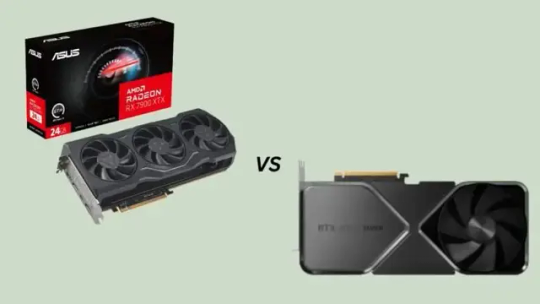
RTX 4080 Super vs RX 7900 XTX
Features, Software, Tech
Radeon RX 7900 XTX
FSR aid for compatibility
With OpenGL 4.6, DX12 Ultimate, HDMI, and ECC Memory, drivers
have improved over time, despite initial RDNA 3 difficulties.
Texture-intensive workloads benefit from VRAM.
Not as advanced as Nvidia’s software.
Nvidia RTX 4080 Super
Frame Gen + DLSS 3
Better AI and ray tracing support
Reflex, RTX Video Super Resolution, and Nvidia Broadcast.
A stronger driver-software ecosystem
Creatives and AI developers’ preferred platform
Video Game Performance
Radeon RX 7900 XTX
3% faster at 1080p (equal).
Around 4% quicker (tied) at 1440p.
At 4K, rasterisation is 7% faster, a significant advantage.
Winners include Call of Duty: MW2 (98 fps at 4K vs. 121).
A modest gameplay advantage for unray-traced games
Nvidia RTX 4080 Super
Some testing show a little 1080p advantage (~3%).
Higher-resolution trails.
Similar to or below the 7900 XTX in rasterisation.
Some games have a consistent frame rate.
Performance Ray Tracing
Gaming Performance
Radeon RX 7900 XTX
Raytracing performance is poor.
Losses average 28–36% across resolutions.
Behind Dying Light 2, Ratchet & Clank, and Cyberpunk 2077 in ray-traced games.
Complete route tracing increases pain.
The poorer ray tracing hardware slows it even with upscaling.
Nvidia RTX 4080 Super
Superior ray tracing performance by 30–70%.
Ratchet & Clank outperforms 7900 XTX by 59–74%.
Has a 90% lead in Minecraft complete path tracing (RTX).
Leads whether upscaling or not.
Much better RT hardware and optimisation
Upscaling and AI
Radeon RX 7900 XTX
FidelityFX Super Resolution 2/3 is supported.
Although FSR supports all GPUs and is more open, image quality is usually lower.
Hardware is replaced with shaders for frame generation.
Together, upscaling and ray tracing are slower.
Fewer people sponsor the less developed frame generation.
Nvidia RTX 4080 Super
Supports AI-powered, hardware-accelerated DLSS 3 (frame generation).
DLSS improves image quality and performance.
Strong game advantage with DLSS + RT
Frame generation and raw fps improvements boost fluidity.
A cutting-edge gaming technology for future professional and AI workloads.
Radeon RX 7900 XTX
SPECviewperf 2020 doubles CAD/engineering performance.
Improved rasterisation skills in Adobe Photoshop and Siemens NX programs.
LLM and large datasets benefit from 24GB VRAM.
Weaker AI acceleration limits training and steady diffusion.
Nvidia RTX 4080 Super
AI workload testing is 89%–156% faster.
Excellent AI training, Blender, and steady diffusion results
Strong FP16 and FP8 computation using Ada Lovelace architecture
Improved Tensor cores and CUDA for developers and AI
Preferred for professional rendering and AI creation Architecture and Specifications
Radeon RX 7900 XTX
RDNA 3.0 structure
The transistor count is 58 billion.
5nm process 1900 MHz base clock, 2500 MHz boost 6144 stream processors (double FP32)
A total of 192 AI and 96 Ray accelerators
24GB GDDR6 VRAM, 384-bit bus width, 960 GB/s bandwidth.
Infinity Cache, 96 MB
355W TDP, dual/triple 8-pin connectors.
Nvidia RTX 4080 Super
Architecture by Ada Lovelace.
45.9 billion transistors 4nm process
Base: 2210 MHz | Boost: 2550 MHz
9728 CUDA cores 320 Tensor Cores | 80 RT Cores
16GB GDDR6X VRAM
Bandwidth: 736.3 GB/s | Bus Width: 256-bit 64 MB L2 Cache
16-pin power connection, 320W TGP power efficiency.
Radeon RX 7900 XTX
355W TDP
High power consumption during load (96.8W for 4K YouTube
streaming) and 19.1W idle power.
Increased heat output may require stronger cooling.
Nvidia RTX 4080 Super
TGP: 320W
More power-efficient, especially for light or idle tasks
31W for 4K YouTube playback 16.5W idle
Power reduction reduces heat, noise, and PSU needs.
Availability
Radeon RX 7900 XTX
Previously hard to find, now common.
A better price-to-performance ratio exists.
Nvidia RTX 4080 Super
Widely available yet often sold for $1,000+ over MSRP.
Provides more dependable availability than the initial 7900 XTX supply. Specifications
#RTX4080SupervsRX7900XTX#RTX4080Super#RX7900XTX#AMDRadeonRX7900XTX#NvidiaGeForceRTX4080Super#RTX4080#technology#technews#technologynews#news#govindhtech
0 notes
Text
🧳 Complete Guide to Women’s Special Tour Packages from Bangalore (By Tejas Travels)

Explore, Empower, Experience – With Women Like You.
🌍 Why Are More Indian Women Choosing to Travel Solo or in Women-Only Groups?
India has seen a 200% rise in solo female travel bookings over the past 5 years, according to MakeMyTrip’s 2024 Travel Trends Report. This shift isn’t just about vacations—it's about freedom, connection, and safety.
Backed by campaigns like UN Women’s Safe Cities, women in metro hubs like Bangalore are now actively joining women-centric travel groups for destinations like Coorg, Hampi, and Kerala.
💡 Real Talk: Bengaluru-based startup worker Shraddha Bhat booked a weekend all-women trip to Chikmagalur through Tejas Travels. Her reason? "I didn’t want to explain myself to anyone. It was freeing to be with women who just get it."
🧭 What Makes Women-Only Tours from Bangalore So Popular?
✨ Comfort in community ✨ Safety-first itinerary planning ✨ Female tour guides ✨ Handpicked, secure accommodations
Travel companies like Tejas Travels are at the forefront—offering women-special packages from Bangalore that are fully curated, inclusive, and flexible.
🎯 Fun Fact: According to WTTC, over 60% of new group tour sign-ups in India are women between 25–45, primarily from urban centers like Bangalore.
🚍 Tejas Travels: The Name You Can Trust in Women’s Group Tours
Looking for reliable bus rental companies for a women’s trip or event? Tejas Travels offers luxury coach rental, wedding bus hire, and curated travel bus rental services—with safety as a top priority.
Whether it’s an overnight road trip to Gokarna or a multi-day experience in Wayanad, their bus rental service includes professional drivers, route optimization, and emergency support.
📆 Example Package: 3-Day All-Women Coorg Getaway 🏞️ ✅ Homestay experience ✅ Guided coffee plantation walk ✅ Yoga mornings & bonfire nights
🗺️ Best Getaways for Women’s Trips from Bangalore (Safe & Stunning)
👒 Coorg – Great for a relaxed nature trip 🎨 Mysore – Cultural spots and food trails 🌊 Gokarna – Beaches + yoga + solo soul searching 🌿 Chikmagalur – Scenic treks, plantations, calm vibes 📸 Hampi – Heritage & architecture with guide-led safety
Bangalore is perfectly placed to access these top-tier, safe zones for women. Tejas Travels covers them all with reliable bus transportation and well-planned itineraries.
🌟 What’s Included in a Women’s Tour Package with Tejas Travels?
✅ Comfortable stay in verified hotels or homestays ✅ All-women support staff and guides ✅ On-road bus services with GPS tracking ✅ Emergency response protocols ✅ Optional add-ons like spa, adventure, or culinary workshops
🚫 What’s Not Included? Shopping expenses, personal items, and last-minute detours. But that’s just more reason to book in advance!
💬 Real Women, Real Stories: Why They Chose Tejas Travels
👩🎓 Ananya, 27, Software Engineer Booked a Goa beach retreat with Tejas Travels: “My mom insisted I go with them after reading reviews. I made lifelong friends.”
👩🦳 Seema, 45, Homemaker Tried the Mysore Wellness Escape: “It felt like I belonged. I could laugh, explore, and not feel judged.”
Tejas Travels proudly boasts a 4.8+ rating on TripAdvisor and glowing feedback for its women’s experiences.
💸 What’s the Cost of a Women’s Special Tour Package from Bangalore?
On average, a 3-day weekend tour starts from ₹8,000 to ₹15,000 per person.
🌈 Factors influencing price: 🎒 Distance & travel mode (like coach rental) 🏨 Stay category (budget vs boutique) 🍽️ Inclusion of meals, experiences, guides
And yes, Tejas Travels offers EMI and group discounts!
✈️ First Time on a Women’s Trip? Here’s What You Should Know
👜 Pack light but smart 📱 Install bSafe or Safetipin 🗣️ Share your itinerary with loved ones 🕊️ Keep an open mind—everyone’s here to explore and evolve
🎤 From a newbie traveler: “I was nervous, but the vibe was respectful and fun. It felt like traveling with cousins.”
✅ How to Book a Spot on the Next Trip with Tejas Travels?
Visit www.tejastravels.com or DM them on Instagram @tejas_travels. Choose from:
🌟 Fixed Date Tours 🌟 Custom Private Women Groups 🌟 Wedding bus hire + Bridal Party Trips 🌟 Corporate Women's Retreats
Their team helps with everything—from planning to bus hire logistics.
❓ Got Questions? You’re Not Alone
Q: Do I need to come with a group? A: Nope! Over 50% of women join solo—many leave with new friends.
Q: Is there a female guide on every trip? A: Yes. That’s a promise.
Q: Can I customize the itinerary? A: Tejas Travels offers semi-flexible packages and custom tours.
👣 Whether you’re a first-timer or a travel veteran, Tejas Travels is here to help you explore the world—on your terms, with your tribe.
💬 Thinking of your next trip? Let’s talk safety, sisterhood, and scenic memories.
Ready to ride? Your seat's waiting.
0 notes